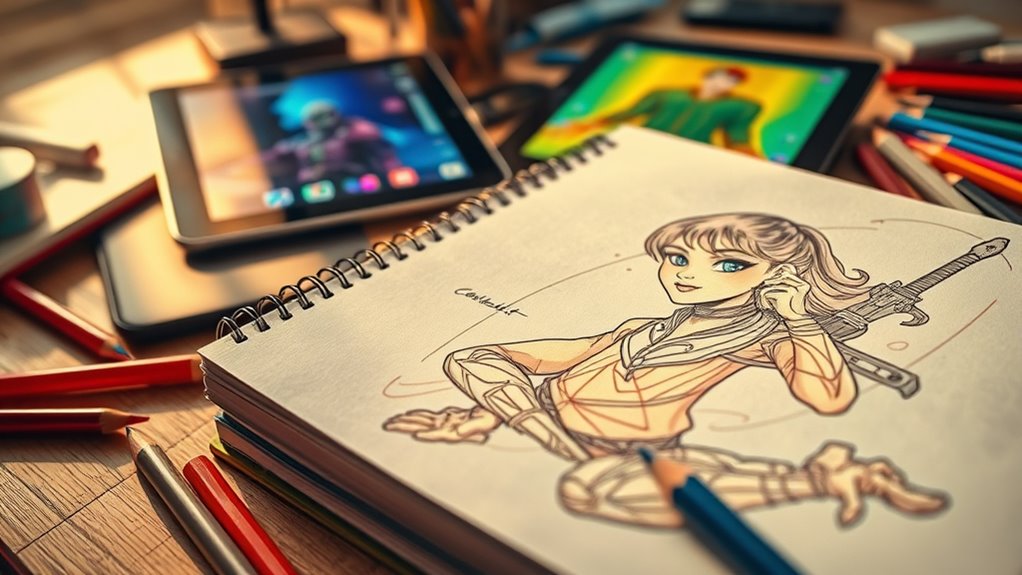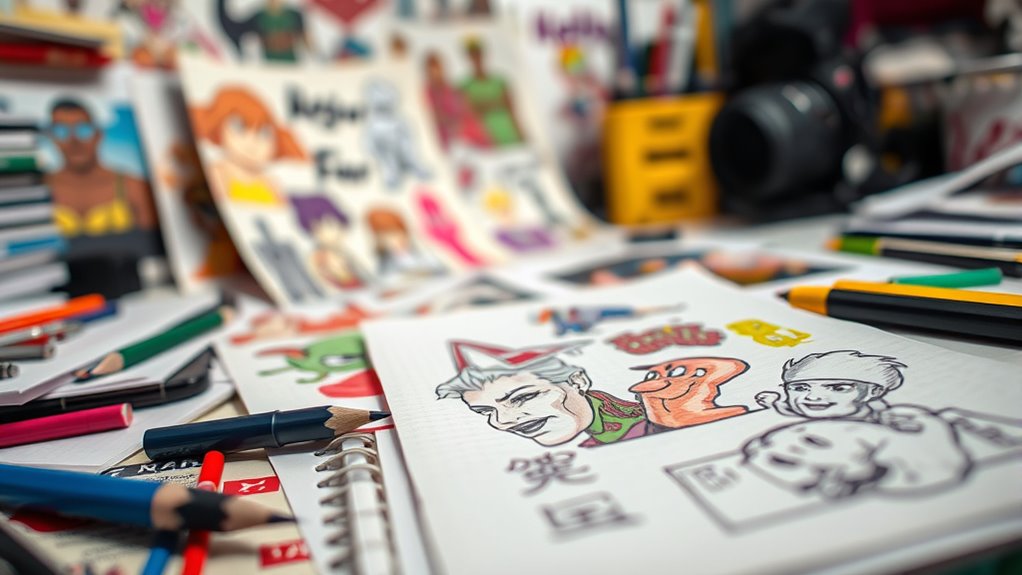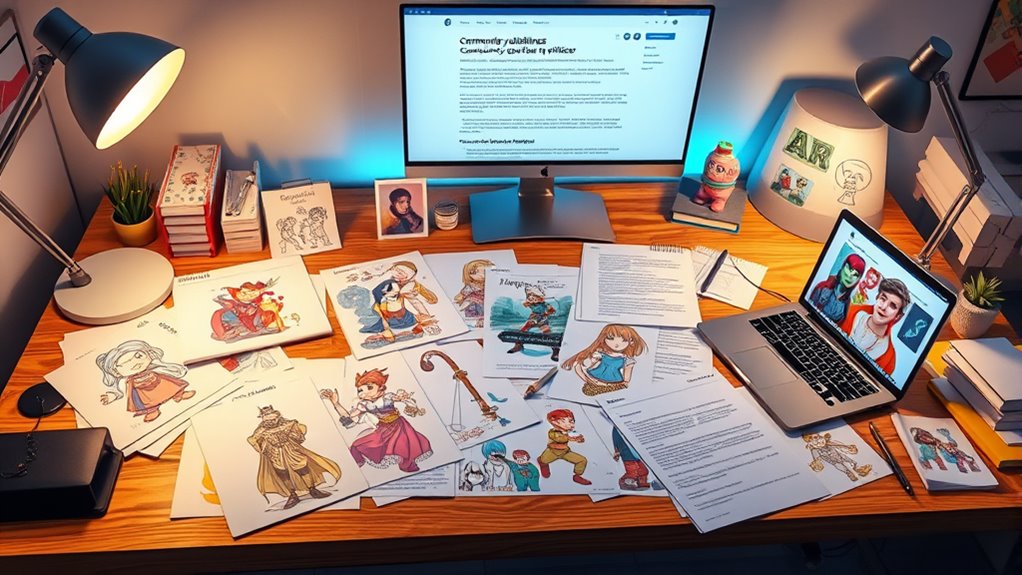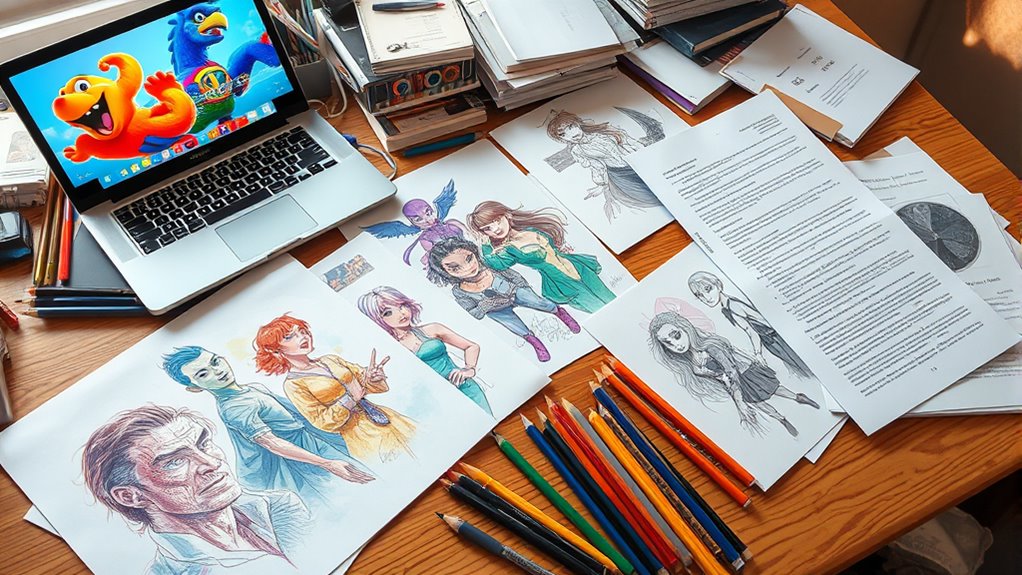When creating fan art, you need to respect copyright and trademark laws, understand fair use limits, and seek permissions when necessary. Avoid monetizing or selling without proper licensing and be aware of platform policies that restrict offensive or infringing content. Staying ethical and transparent helps prevent legal issues and preserves your reputation. If you want to learn how to navigate these rules effectively, you’ll find valuable insights if you keep exploring.
Key Takeaways
- Respect original copyrights and obtain permissions or licenses before creating or selling fan art.
- Use fair use cautiously; transformative work with added meaning offers better legal protection.
- Avoid infringing trademarks by steering clear of brand logos, slogans, or distinctive character designs.
- Follow platform policies on content, credit, and commercial use to prevent content removal or account suspension.
- Clearly disclose fan art status, maintain records, and avoid excessive commercial activities to protect legal and ethical integrity.
Understanding Copyright and Intellectual Property Rights

Understanding copyright and intellectual property rights is essential when creating or sharing fan art. These rights protect original works, including characters and stories from popular media. If you plan to monetize your fan art, such as selling prints or merchandise, you must recognize that creator rights belong to the original creators or copyright holders. Fan art monetization can lead to legal issues if you infringe on these rights, so it’s crucial to understand what’s permissible. Respecting copyright laws ensures you avoid potential lawsuits and respects the intellectual property of others. Knowing how copyright works helps you make informed decisions about sharing and possibly monetizing your work while respecting the rights of original creators. Ultimately, understanding these rights keeps your creative efforts legal and respectful. Additionally, being aware of holistic approaches to health and wellness can guide you in creating content that aligns with community standards and promotes positive engagement.
The Difference Between Inspiration and Infringement

You need to understand how fair use can protect your fan art when it’s inspired by existing works, but it’s not a free pass for copying. Avoid trademark violations by being careful not to create confusion or imply official endorsement. Recognizing these boundaries helps you stay within legal limits while expressing your creativity. Additionally, understanding the specific beneficial ingredients used in products like eye patches can help you make informed choices about what to incorporate into your own skincare routine.
Recognizing Fair Use
How can you tell if your fan art falls under fair use or crosses into infringement? Recognizing fair use involves evaluating whether your work transforms the original, aligns with fan art ethics, and respects community guidelines. Think of it as a balancing act:
- Purpose: Is your art for commentary, parody, or education rather than profit?
- Amount: Are you using only what’s necessary, avoiding copying entire images?
- Effect: Does your fan art harm the original’s market or value?
- Transformation: Does your work add new meaning or context, making it more than just a copy?
Additionally, understanding the importance of self-awareness can help creators navigate their intentions and the impact of their work.
Avoiding Trademark Violations
While fair use focuses on copyright protections, avoiding trademark violations requires a different approach. You need to respect the brand recognition that trademarks create, which is what makes a company’s logo or name instantly recognizable. Using a trademark in your fan art without permission can lead to brand dilution, where the original brand’s uniqueness becomes less distinct. To avoid infringing, steer clear of creating works that could confuse viewers into thinking there’s an official endorsement or partnership. Focus on creating inspired artwork rather than directly copying trademarked elements. By doing so, you preserve the integrity of the original brand and avoid legal issues. Additionally, understanding contrast ratio can help ensure your artwork maintains visual clarity and impact, even in fan creations. Remember, the key is to celebrate your favorite characters without risking your work being mistaken for official merchandise.
Fair Use Doctrine and Its Limitations

You need to understand that the fair use doctrine has limits, especially when it comes to transformative use. If your fan art substantially alters the original or is used commercially, it’s less likely to qualify as fair use. Recognizing these distinctions helps you avoid legal trouble and respect intellectual property rights. Additionally, understanding personal growth concepts can aid creators in developing a mindful approach to their work.
Transformative Use Limits
Transformative use is a key concept in fair use analysis, but it has clear limits. Its core is the transformative purpose—does your fan art add new expression or meaning? If your work creates a derivative work that transforms the original, it might qualify. But beware: courts look for specific factors. Imagine your art:
- Reimagining a character in a different setting
- Changing the style or medium markedly
- Adding commentary or critique
- Creating something entirely new from the original
If your work primarily copies or mimics without enough transformation, it’s less likely to be protected. The goal is to show how your fan art is more than just a replica—it’s a new, original piece that advances fair use limits through a genuine transformative purpose. Additionally, understanding content ownership can help clarify the boundaries of permissible derivative works.
Commercial vs. Nonprofit
The commercial nature of fan art substantially influences its fair use protections. When you create fan art for profit, courts often view it less favorably under fair use, as it may infringe on the original creator’s rights. Nonprofit fan art, however, tends to fall closer to fair use, especially if it’s transformative and respects fan art ethics. You must navigate creative boundaries carefully, ensuring your work doesn’t harm the market value of the original. While nonprofit projects might have more legal leeway, they’re not automatically protected. Understanding these distinctions helps you avoid legal pitfalls. Ultimately, balancing your passion with respect for intellectual property rights is key, whether your intent is commercial or nonprofit. Additionally, the emotional and poetic language often used in fan art can influence how courts interpret transformative work and fair use.
Permissions and Licensing for Fan Art

Managing permissions and licensing is essential when creating fan art, as it determines whether your work respects the rights of original creators. You should consider fan art contracts and licensing agreements to stay compliant. Imagine: 1) signing a document with a pen, outlining your rights; 2) reviewing terms that specify how you can display or sell your art; 3) understanding restrictions on modifying the original work; 4) negotiating permissions directly with rights holders if needed. These steps help clarify what’s allowed and protect you from legal issues. Always verify your licensing agreements are clear and in writing, so you know your boundaries. Respectful licensing not only safeguards your creative freedom but also maintains a positive relationship with original rights holders, especially when considering content licensing to ensure your work aligns with legal standards.
The Role of Trademarks in Fan Creations

Have you ever wondered how trademarks influence fan creations? Trademarks serve as brand identifiers, helping owners protect their intellectual property through trademark enforcement. When you create fan art, you might use logos, symbols, or character designs linked to a brand. These elements are protected to prevent confusion and unauthorized use. Brands actively monitor and enforce trademarks to maintain brand protection, which can impact your ability to share or sell fan art. Understanding this helps you respect legal boundaries and avoid infringing on trademarks. Here’s a quick overview:
| Trademark Element | Purpose | Example |
|---|---|---|
| Logos | Brand recognition | Company logos in fan art |
| Slogans | Brand messaging | Catchphrases in fan works |
| Character Designs | Visual identity | Iconic character features |
| Symbols | Trademark identity | Trademarked emblems |
Being aware of trademark enforcement ensures you’re respectful of intellectual property rights. Additionally, trademark enforcement can vary based on jurisdiction and context, so it’s important to stay informed about local laws.
Platform Policies and Community Guidelines

Platforms hosting fan art often have strict policies and community guidelines that you must follow to avoid content removal or account suspension. These platform policies set clear boundaries, such as:
- Ensuring your art doesn’t infringe on copyrighted characters.
- Avoiding explicit or offensive content that violates community standards.
- Giving proper credit to original creators when required.
- Respecting the platform’s rules on commercial use or sales.
Best Practices for Sharing and Selling Fan Art

To share and sell fan art responsibly, you should always respect copyright laws and platform policies while being transparent about your intentions. Practicing good fan art etiquette means honoring the original creators’ rights and setting clear creative boundaries. This helps maintain positive relationships with both fans and rights holders. When sharing, consider whether your work aligns with fair use or if licensing is needed. For selling, always disclose your relationship with the original work and avoid claiming ownership. Use the following table to guide your approach:
| Fan Art Etiquette | Creative Boundaries |
|---|---|
| Respect original creators | Avoid copying excessively |
| Disclose your intentions | Keep clear boundaries on commercial use |
Following these guidelines ensures your fan art activities are responsible and respectful. Ethical considerations, like understanding copyright laws, play a crucial role in ensuring your activities are within legal boundaries.
Navigating Legal Risks and Protecting Yourself

Sharing and selling fan art responsibly helps you stay within legal boundaries, but it doesn’t eliminate all risks. To protect yourself, consider these key steps: 1. Clearly label fan art merchandise with proper fan art attribution, acknowledging the original creator and source. 2. Limit commercial use; avoid mass-producing or selling fan art without permission. 3. Keep detailed records of your creations, including sketches, references, and correspondence. 4. Stay informed about copyright laws and fair use policies to understand what’s permitted. Additionally, understanding electric horsepower of related fan art subjects can help you better grasp the scope of creative influence and avoid infringement.
Frequently Asked Questions
Can I Sell Fan Art Without Facing Legal Consequences?
You might wonder if you can sell fan art without legal trouble. Generally, selling commercial fan art risks copyright infringement unless you have fan art licensing from the copyright holder. Creating and selling non-commercial fan art for personal use is usually safer, but once you start making money, you could face legal consequences. To stay safe, consider obtaining permission or licensing, especially for commercial fan art.
How Do I Properly Credit Original Creators in My Fan Art?
You might find it surprising how often proper attribution best practices can prevent legal issues. When creating fan art, you should clearly acknowledge the original creator’s work with a visible credit, including their name or social media handle. This guarantees you’re practicing good creator acknowledgment, showing respect and transparency. By doing so, you help protect yourself legally and honor the original artist’s rights, fostering a positive community around your art.
Are There Specific Platforms That Are More Lenient With Fan Art?
You might find that some fan art communities and social media platforms are more lenient with fan art, especially those with relaxed platform policies. Platforms like DeviantArt and Tumblr often support fan creations more openly, but always check their specific rules. While these communities may be more tolerant, it’s still smart to respect copyright laws and credit original creators, even on platforms with lenient policies.
What Are the Penalties for Copyright Infringement in Fan Art?
When you create fan art, copyright infringement penalties can be serious, including legal action, fines, or takedowns. If you’re involved in trademark disputes, it can complicate things further, risking more legal trouble. However, using a fair use defense might help in some cases, especially if your art transforms the original work or comments on it. Always consider these legal aspects before sharing your fan art publicly.
How Can I Legally Use Copyrighted Characters in My Work?
Think of using copyrighted characters like walking a tightrope—you need balance. To stay legal, explore Fair Use, which allows limited use of copyrighted material for commentary or criticism, and create Derivative Works that transform the original. Always give credit, avoid copying directly, and consider licensing if possible. These steps help you enjoy creating fan art without falling into legal trouble, keeping your passion safe and sustainable.
Conclusion
Now that you know the legal maze of fan art, you’re practically a superhero armed with the power to create without chaos! Avoiding infringement and respecting rights might seem tricky, but with these tips, you’ll dodge legal landmines like a master. Keep permissions in your back pocket and always play by the rules—before you know it, you’ll be ruling the fan art universe without a single lawsuit in sight. Go forth and create fearlessly!









